The mineral pyrite, also called “fool’s gold,” has fascinated people for hundreds of years. It got its name because it looks like shiny gold, which makes people think they have found real gold.
If you are wondering how to tell the difference between real and fake pyrite, it’s not always easy to tell just by looking. Both have a metallic sheen and are golden, but some things make them different.
However, it can be hard to tell the difference without the right knowledge or tools. This is where our article comes in! We’ve put together a guide to help you distinguish real pyrite from fake ones and even from real gold.
Our article will provide essential information and tips, making it easier to identify these minerals.
So, whether you’re a budding geologist, a treasure hunter, or just someone curious about rocks, our guide is here to help you learn more about the intriguing world of pyrite!
Understanding Natural Pyrite And Why Fakes Are Common
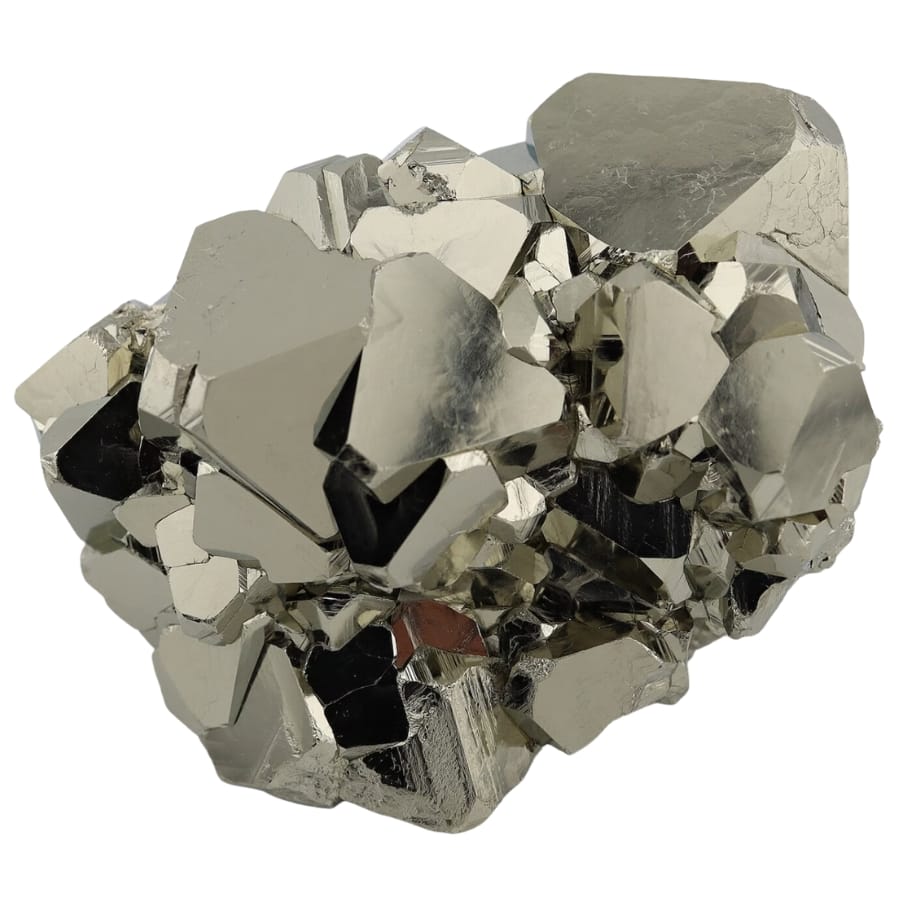
Pyrite, sometimes called “fool’s gold,” is an exciting mineral that looks like gold and has a metallic sheen. It can form in sedimentary rocks, volcanic areas, and fossils.
What’s cool about pyrite is that it often forms perfect cube shapes or groups of cubes, which rarely happens in nature. Pyrite is also hard, heavy, and brass-yellow.
In the past, pyrite was used in fire-starting kits. Its name, “pyrite,” comes from the Greek word for fire, which means it can make sparks when struck against metal or stone.
These days, pyrite is used in jewelry and as a decorative stone to add sparkle and mystery to different things. Scientists study it to learn about past environments and use it in some industrial processes.
Pyrite is valuable not only because it looks nice, but also because it helps us understand Earth’s past. It’s not as useful as real gold, but collectors, geologists, and anyone interested in geology will find it fascinating.
Why you’re seeing more fake pyrite these days
Fake pyrite is becoming more common for a few reasons. Real pyrite is popular because it looks like real gold but is much cheaper. This makes some people want to make and sell fakes to make money.
Better technology has also made making fakes that look a lot like the real thing easier. And, more people are shopping online, which makes it easier for these fakes to reach more people.
How To Identify Real Pyrite
Pyrite is a mineral that often tricks people with its gold-like appearance. Identifying real pyrite involves understanding its unique characteristics, such as color, crystal structure, and hardness.
In this section, we’ll explore the key features that distinguish genuine pyrite from imitations, helping you to become a savvy mineral enthusiast.
It can be hard to identify what rocks you have, so we have made it easy for you by giving you guides to rocks and minerals from every state.
When you know more about a pyrite, you buy it wisely and appreciate and enjoy its beauty more.
Check the shape and structure

Real pyrite generally has a very clear shape and comes in cubes or groups of cubes. The sides of these cubes are sharp, and the tops are flat and shiny.
What makes them unique is that they look almost like a person made them. They can be big or small. Pyrite can take on less-than-perfect shapes sometimes, but it still has a sense of order and balance.
The design on the pyrite’s surface is something else to look at. There are striations, which look like small lines or grooves, on the cube faces of real pyrite. This is likely real pyrite because it has these lines on it.
Looking at these shape and structure features, you can pretty quickly tell if something is real pyrite.
Do a hardness test
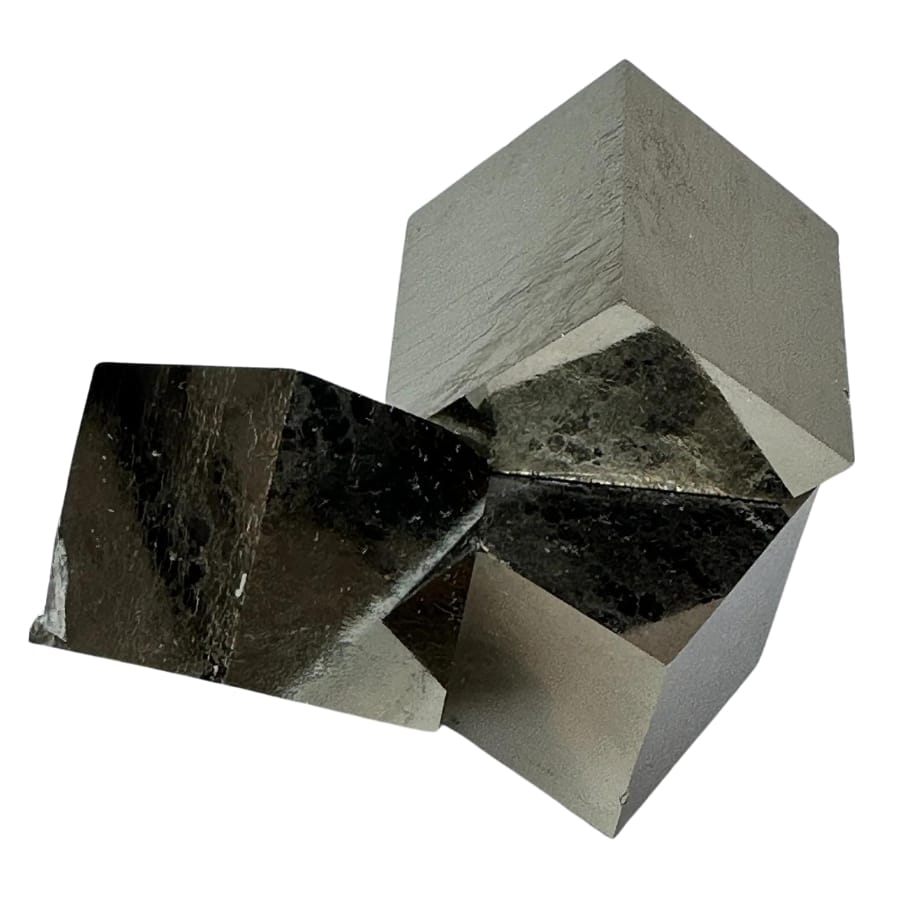
You need to scratch pyrite with something like a copper penny or a pin to see how hard it is and ensure it’s real. Based on the Mohs measure of mineral hardness, pyrite is pretty tough.
It scores between 6 and 6.5. It’s tougher than a copper penny, which is about a 3. If you scratch the pyrite with a penny and nothing comes off, it’s real. It might not be pyrite if the penny does scratch it.
Be careful as you do this test. The pyrite and the penny should stay safe. It’s only a small scratch to see if the penny leaves a mark. This test is useful because real pyrite is tough and won’t be easily scratched by metals that aren’t as hard.
Inspect magnetic properties
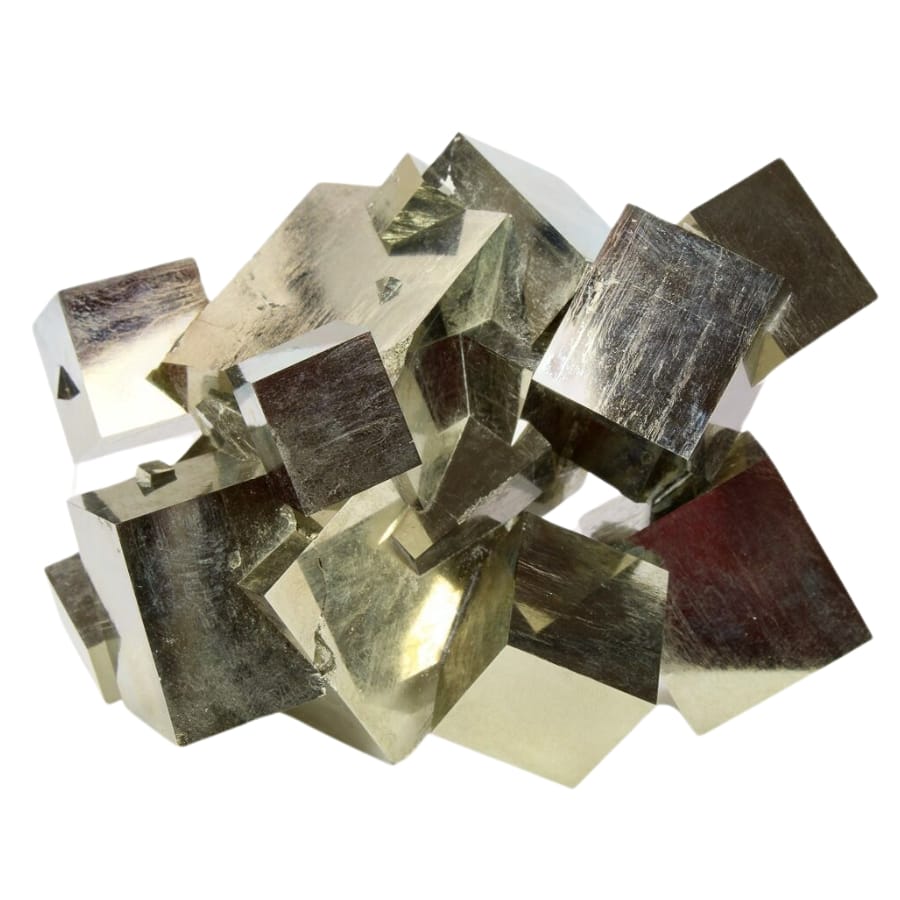
Inspecting the magnetic properties of pyrite to make sure it’s real is pretty simple. You just need a strong magnet. Real pyrite can be slightly magnetic, but not very strongly.
So, if you hold a magnet close to the pyrite and it gets attracted a little, that’s okay. But, if the pyrite jumps to the magnet strongly, like it’s really stuck to it, that’s a sign it might not be real.
Some fake pyrites are made with more magnetic materials. Remember, the key here is that real pyrite is only weakly magnetic. If you don’t have a strong reaction from the magnet, that’s a good sign.
Also, the magnet test is easy and doesn’t harm the pyrite, so it’s a good way to check.
Measure the weight
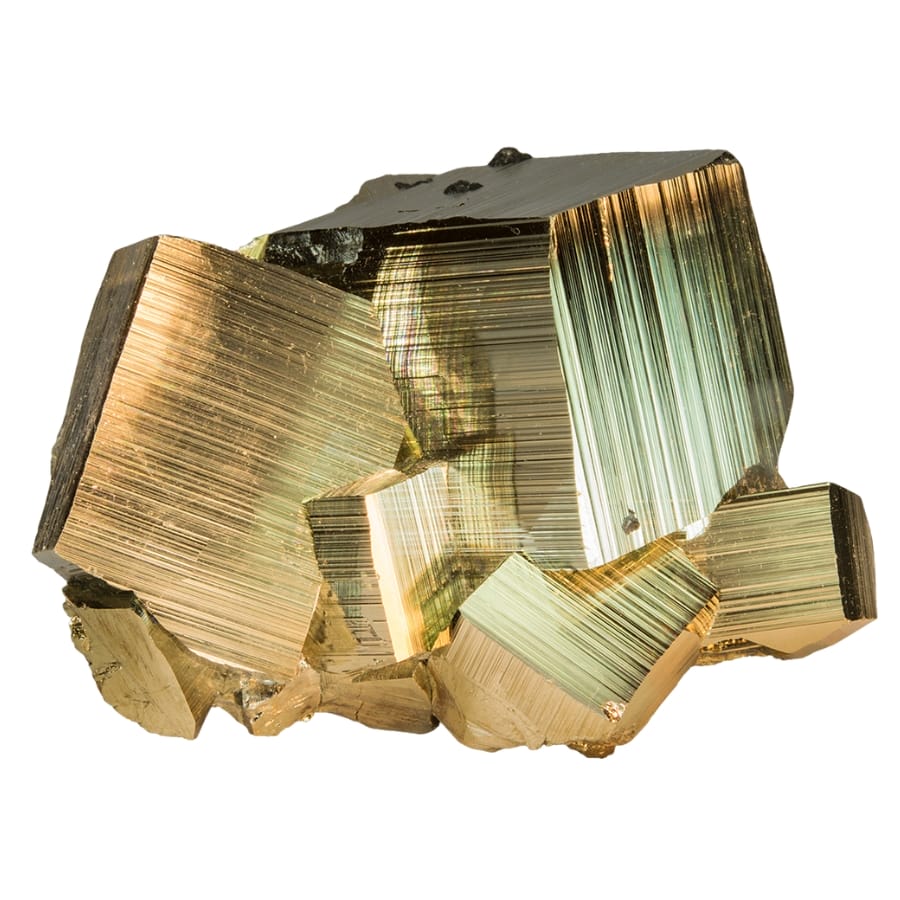
Measuring the weight of pyrite to make sure it’s real is a helpful trick. You’ll need a small scale for this. Real pyrite is pretty heavy for its size because it’s made of iron and sulfur.
When you put the pyrite on the scale, compare its weight to what you’d expect from a rock of its size. If it feels surprisingly light, like it’s not weighing much, then it might not be real pyrite.
Sometimes, things that look like pyrite but are made of lighter materials like plastic or resin are sold as pyrite. These fakes won’t weigh as much as the real thing.
So, if your pyrite feels heavy and matches up with the expected weight for something made of iron and sulfur, it’s likely real. This weight test is a good way to check, along with looking at other features like color and shape.
Observe the color and shine
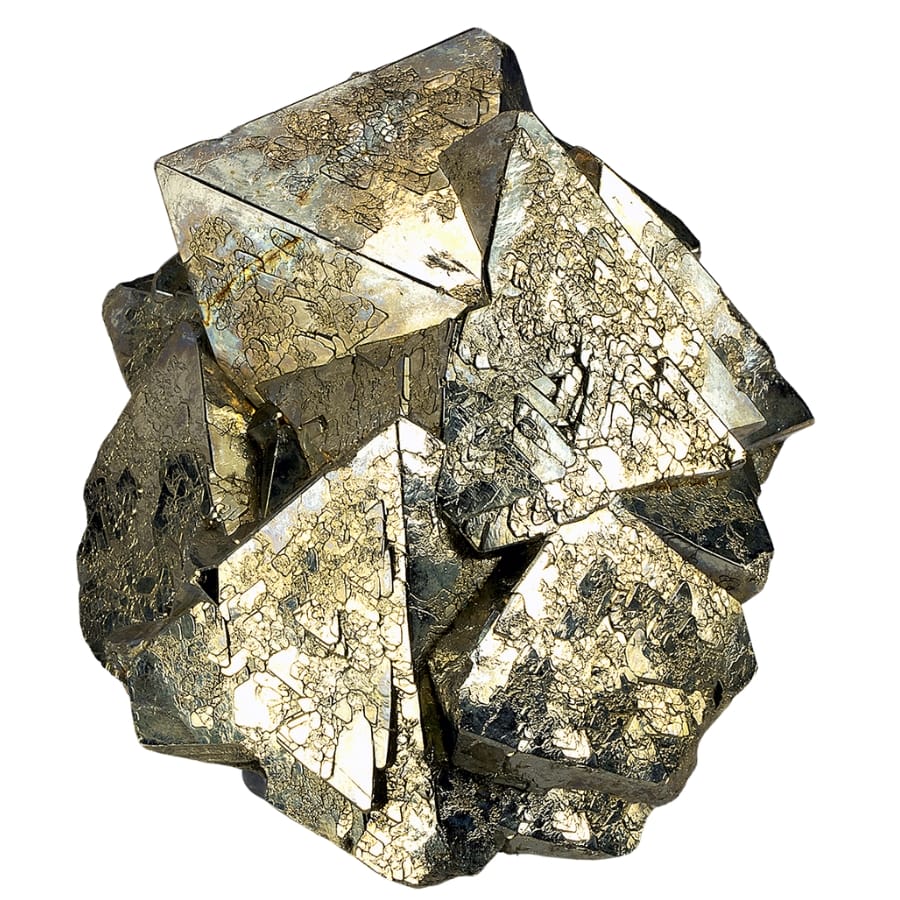
Observing the color and shine of pyrite to make sure it’s real is all about paying attention to details. Real pyrite has a unique color – it’s a brass-yellow. This means it’s not as bright as gold; it has more of a metallic, slightly darker yellow look.
Also, pyrite has a very shiny, metallic luster. This means it reflects light almost like a metal does. When you hold it up to the light, it should sparkle brightly.
If the color looks too dull or too bright, like it’s painted, or if it doesn’t shine brightly in the light, it might not be real pyrite.
Fakes often don’t get the color quite right, and they might not have the same kind of shiny, metallic look that real pyrite has. So, if it’s brass-yellow and really shiny, it’s more likely to be real pyrite.
The Different Types Of Fake Pyrite And What They Look Like
There are various types of fake pyrite, and each one feels and looks different. Even though they all claim to be pyrite, you can tell them apart by their weight, feel, and shine. We’ll talk more about each type below.
Chalcopyrite
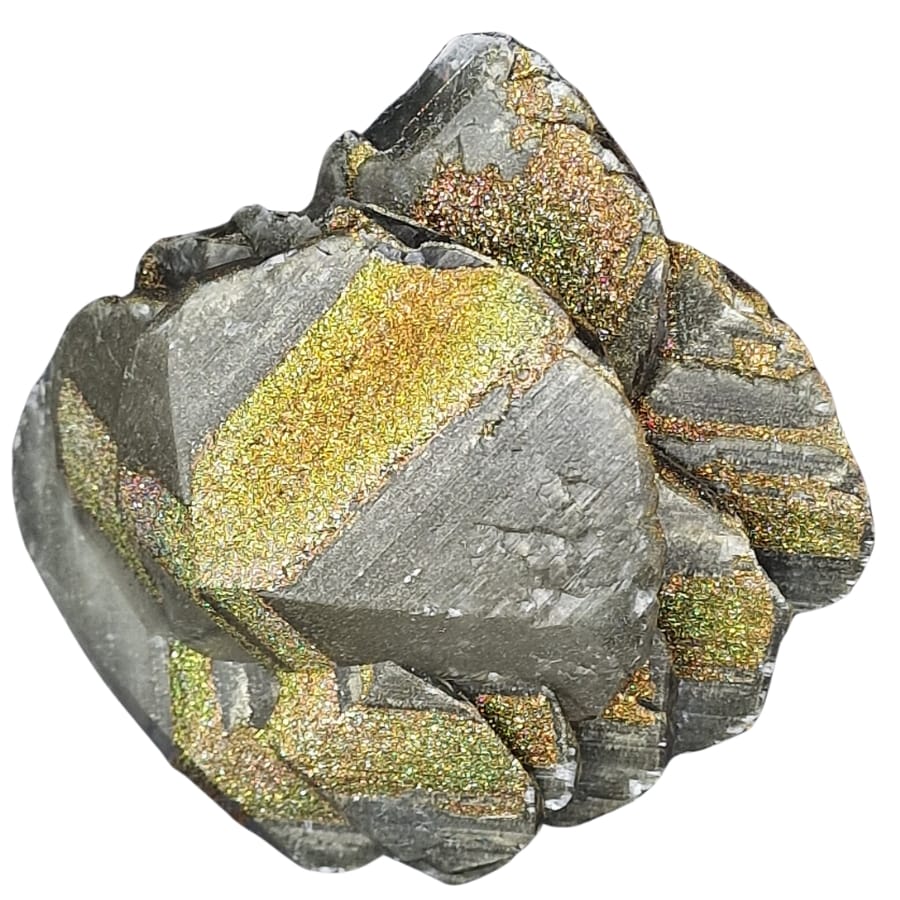
Chalcopyrite is a mineral that is sometimes confused with pyrite. This is why some people sell it as pyrite. Deep in the ground, it forms where hot fluids full of minerals move through rocks.
It’s made up of many different elements, such as copper and iron, that come together to make chalcopyrite. Although it looks like pyrite because it is shiny and metal, it’s not the same.
There are more colors in chalcopyrite than in pyrite. It may start out as a bright yellow color, but after being out in the air for a while, it may start to turn purple, blue, and green.
The copper in the chalcopyrite mixes with the air, which makes it turn this color. On the other hand, pyrite mostly stays the same brass-yellow color even after it rusts.
How you can identify “chalcopyrite” being sold as real pyrite
Change of color
Chalcopyrite has a brighter yellow color compared to pyrite’s brass-yellow. If you notice the mineral changing colors, especially showing greens, purples, or blues when it tarnishes, it’s likely chalcopyrite.
Pyrite usually stays the same brass-yellow even when it tarnishes.
Less defined crystals
While pyrite often forms in well-defined cubes or clusters of cubes, chalcopyrite tends to have a less defined, more irregular crystal structure.
If the mineral lacks those sharp, cube-like shapes that pyrite is known for, it might be chalcopyrite.
Softer texture
Chalcopyrite is softer than pyrite. You can do a simple scratch test; try scratching it with a nail or a copper penny.
If it scratches easily, it’s more likely to be chalcopyrite, as pyrite is pretty hard and doesn’t scratch easily.
Glass Pyrite
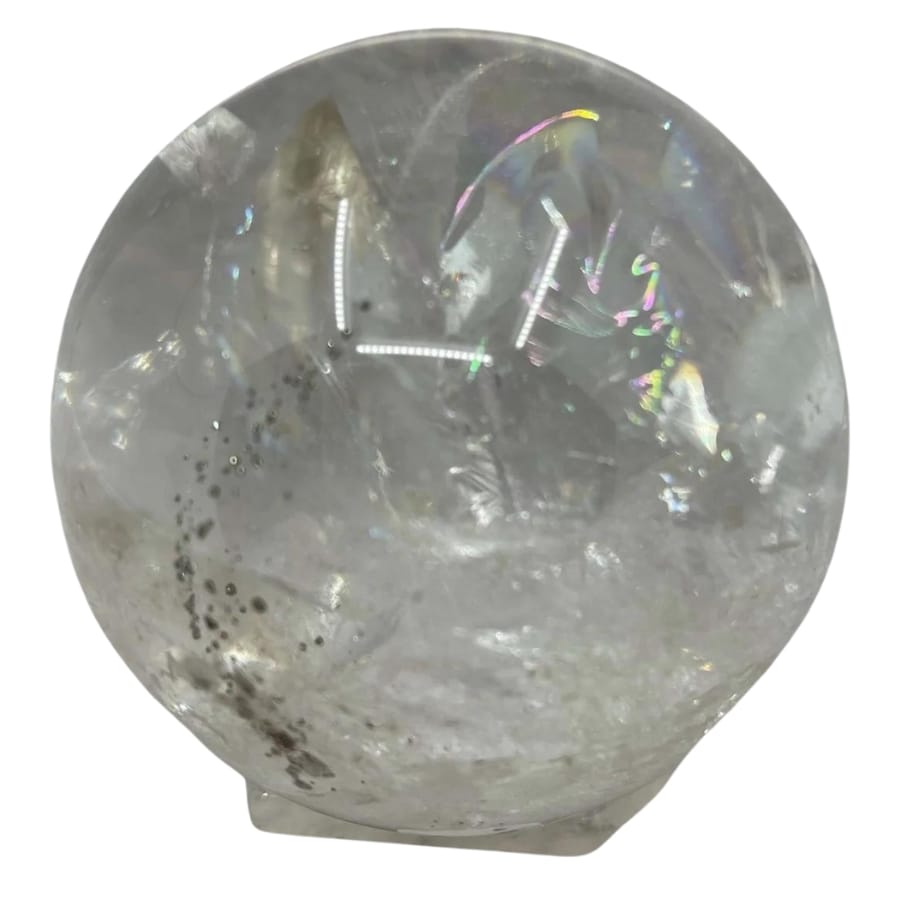
Glass pyrite is actually not a natural mineral at all – it’s something that people make to look like real pyrite. The process starts with glass. Glass is melted and then shaped into forms that resemble natural pyrite crystals.
These glass pieces are often molded to have cubic shapes, just like real pyrite does, because pyrite is famous for its cool cube-like crystals.
After the glass is shaped, it’s colored to make it look like pyrite. The color used is usually a metallic paint or a treatment that gives it a gold or brass-like appearance.
This is important because real pyrite is known for its shiny, metallic, brass-yellow color. The goal is to make the glass mimic this as closely as possible.
How you can identify “glass pyrite” being sold as real pyrite
Check the feel and weight
Glass pyrite feels smoother and is usually lighter than real pyrite. If the piece feels unusually light for its size or if the surface feels too smooth and glass-like, it might be glass pyrite.
Examine for breakage and chips
Glass pyrite can chip or break more easily than real pyrite. If you see sharp, uneven breakages or chips that look like broken glass, it’s likely not real pyrite.
Real pyrite is quite hard and breaks along natural lines, not in sharp, glassy shards.
Lack of metallic luster
Although glass pyrite can be shiny, it doesn’t have the same metallic luster as real pyrite. Real pyrite shines like metal, while glass pyrite might just look glossy or shiny. If the shine doesn’t resemble that of a metal, it’s probably glass.
Gold Spray-painted Rocks
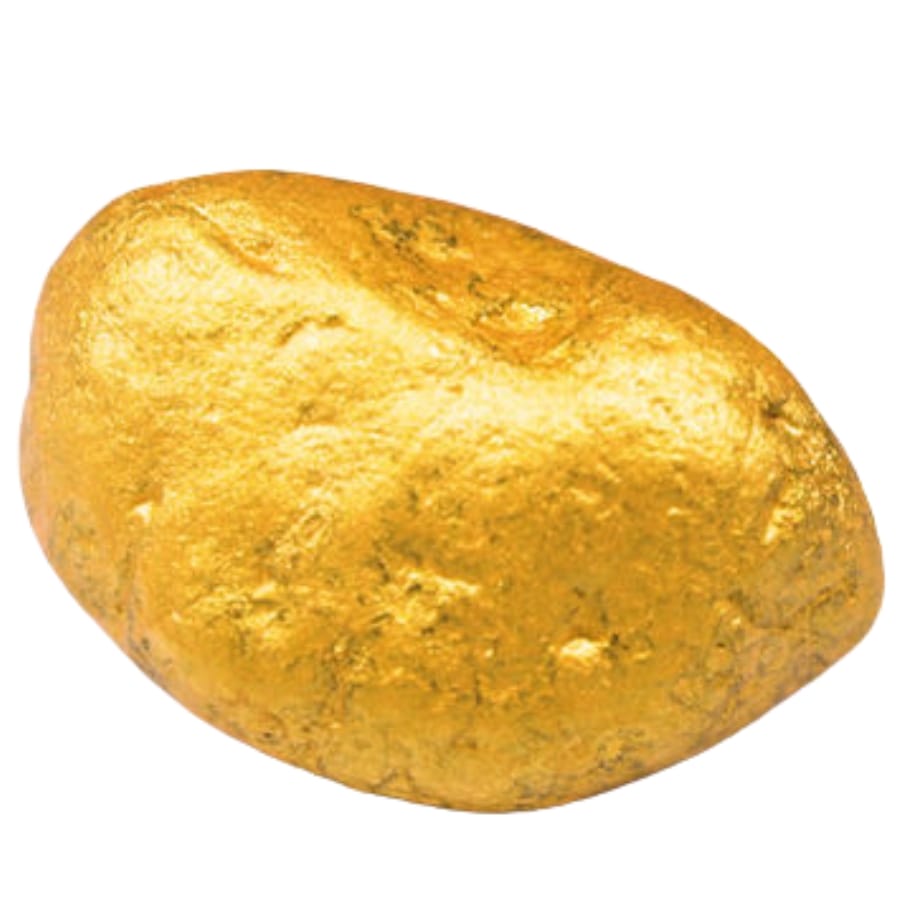
Because they are so easy to make, gold spray-painted rocks are often used to make fake pyrite. At first, there are just plain rocks, the kind you can find anywhere. It doesn’t matter how cool these rocks are; the paint is what makes them work.
To make sure the paint sticks well, the rocks are cleaned first. Following that, a gold paint is sprayed on them. This paint was chosen to look like the shiny, metallic look of real pyrite, which is a brassy yellow stone with a metallic shine.
After painting the rocks, they are left to dry. It’s important to let the paint dry because it sets on the rocks. Once these rocks are dry, they might seem a lot like pyrite at first glance, especially if they’re coated with care.
They can be sold as fake pyrite because of this. Minerals are often sold to people who don’t know much about them or used as decorations.
How you can identify “gold spray-painted rocks” being sold as real pyrite
Lack of crystal structure
Pyrite usually forms in cube shapes or clusters of cubes. If the rock lacks these shapes and just looks like a regular rock with a gold coating, it’s likely a spray-painted rock, not real pyrite. Real pyrite has a distinct, geometric crystal structure.
Paint chipping
If you see any spots where paint is chipping or flaking off, revealing a different color or material underneath, it’s a sign that the rock is just spray-painted. Real pyrite doesn’t chip or flake like paint does.
Uneven color
Look closely at the color of the rock. If the gold color looks uneven, with some areas brighter or darker than others, it might be spray paint. Real pyrite has a consistent, metallic brass-yellow color all over.
Plastic Pyrite
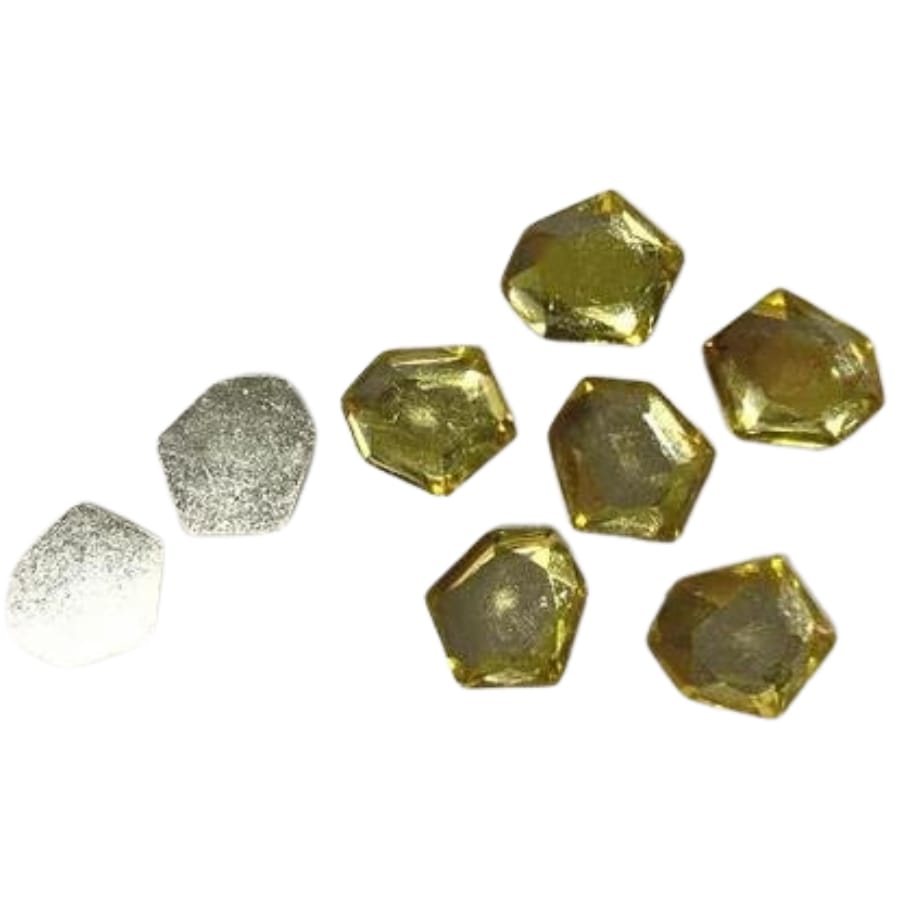
Plastic pyrite is another type of fake pyrite that people make and sell. It starts with plastic, which is a material that can be easily shaped and colored. The plastic is melted and poured into molds that are shaped like pyrite crystals.
Real pyrite often forms in cool cube shapes, so these molds try to copy that. Once the plastic hardens in the mold, it takes on the shape of pyrite crystals.
After the plastic is shaped, it’s painted to look like pyrite. A metallic, brass-yellow paint is used because that’s the color of real pyrite. This paint is important because it makes the plastic look more like the real mineral.
The plastic pieces are then coated with a shiny finish to give them a lustrous, metallic look. This is to mimic the way real pyrite reflects light.
How you can identify “plastic pyrite” being sold as real pyrite
Burning test
If you carefully hold a flame (like from a lighter) to the suspect pyrite and it melts or smells like burning plastic, it’s definitely not real pyrite.
This test should only be done with adult supervision and in a safe area because it involves fire and can be dangerous. Real pyrite will not melt or smell like plastic when heated.
Do a weight test
Plastic pyrite is much lighter than real pyrite. If you pick up a piece and it feels surprisingly light for its size, it might be made of plastic. Real pyrite is pretty heavy because it’s a dense mineral.
Warm to the touch
Plastic tends to feel warm or at room temperature when you touch it. Real pyrite, being a metal mineral, usually feels cool to the touch, especially if it hasn’t been held in your hand for long.
Mica Flakes
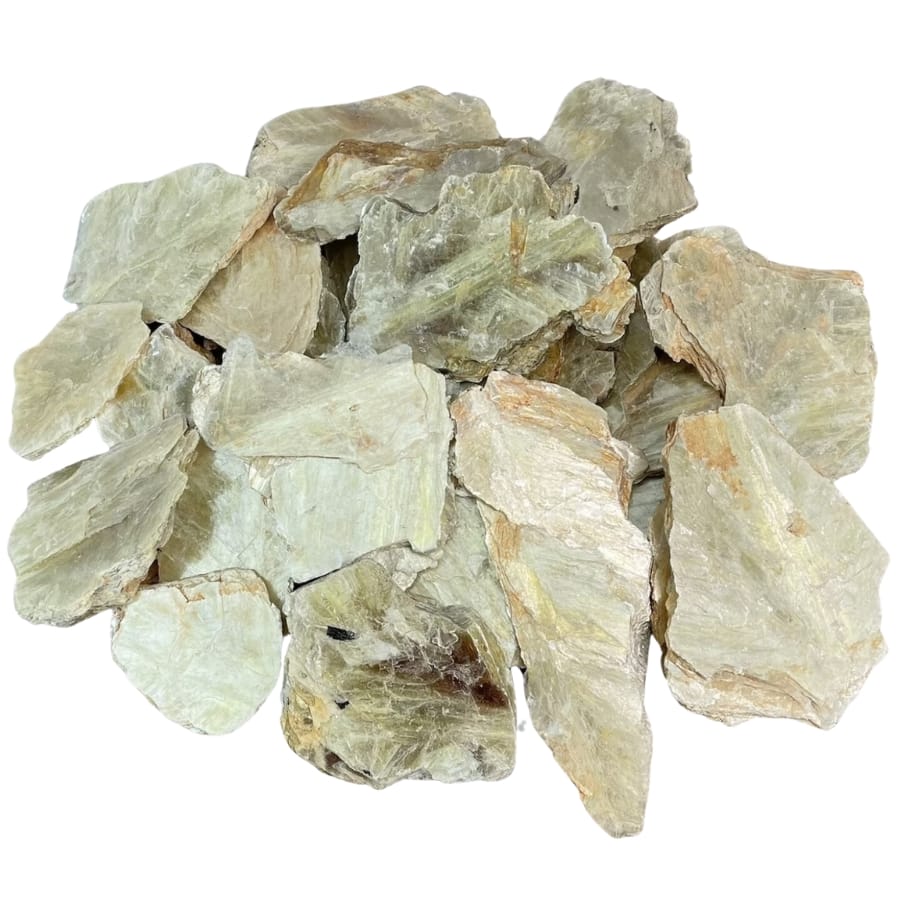
Mica flakes are another material sometimes used to make fake pyrite. Mica is a natural mineral, but it’s very different from pyrite. It forms thin, flat layers in the earth.
These layers can be peeled off into flakes, a unique feature of mica. It’s kind of like how you can peel layers off an onion. Mica is shiny, but its shine is more glittery, not like the metallic luster of pyrite.
To use mica flakes as fake pyrite, people collect these thin layers of mica. Sometimes, they’re broken into smaller pieces to look more like the size of pyrite crystals.
Mica naturally has a bit of a golden or silver shine, which can make it look a bit like pyrite at a quick glance. This is why some people might think it’s pyrite if they don’t look too closely.
How you can identify “mica flakes” being sold as real pyrite
Check for the peeling layers
Mica flakes can be peeled apart into thin layers, almost like sheets of paper. If you can easily split the mineral into thin, flexible sheets, it’s likely mica, not pyrite. Real pyrite is solid and doesn’t peel apart.
It has softer texture
Mica is much softer than pyrite. You can test this by trying to scratch it with your fingernail. If your nail leaves a mark or if the mineral feels soft and flaky, it’s probably mica. Pyrite is hard and won’t scratch easily.
Lack of metallic luster
While mica can be shiny, it lacks the metallic luster that pyrite has. Mica tends to sparkle or shimmer, but it doesn’t look like metal. If the shine of your mineral is more glittery than metallic, it might be mica.
How To Tell If Pyrite Is Real Vs Fake
Here, we’ll discuss the main differences between real and fake pyrite, including some tests and notes you can make. You will learn how to easily tell if the pyrite in your collection or while buying are real.
How To Identify Fake Pyrite When It’s Cut Or Polished
When trying to identify fake pyrite, especially when it’s cut or polished, there are several key aspects to consider. Understanding these differences is important for telling the difference between real pyrite and fakes, so you can correctly identify the type of mineral you are looking at.
Reaction to magnets
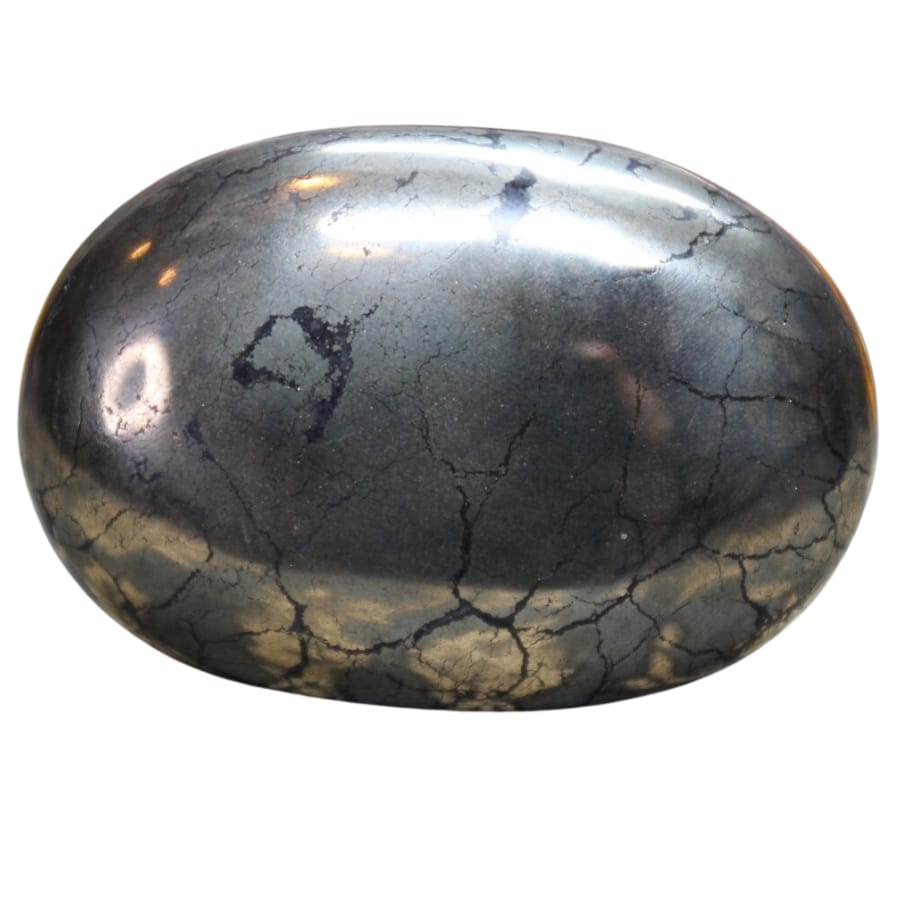
If you want to be sure that a piece of cut and polished pyrite is real, all you have to do is test it with magnets. To begin, you need a strong magnet. Real pyrite is sometimes magnetic, but not very much of the time.
Keep the magnet close to the piece of pyrite. If the pyrite sticks to the magnet or jumps to it, that means it might not be real. Some fake pyrites are made from things that are stronger at magnets.
If there isn’t any pull at all or just a little pull, that’s more like real pyrite. It’s easy to do this magnet test, and it doesn’t hurt the pyrite.
It helps you figure out if the piece you cut and cleaned is real or not. Remember that the magnetic pull of real pyrite is usually not very strong.
Scratch test result
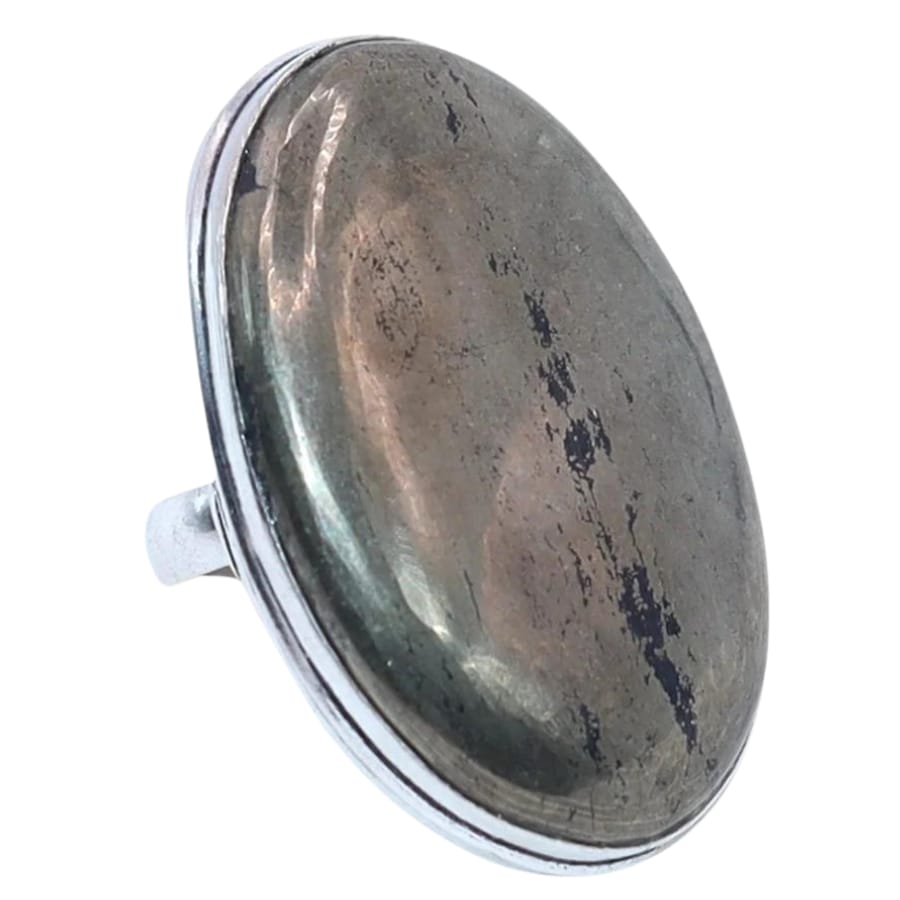
Even if the fake pyrite has been cut and cleaned, it’s easy to tell the difference with a scratch test. For this test, you’ll need a small steel nail or a copper penny. On the Mohs scale of material hardness, real pyrite is about 6 to 6.5.
Copper, which is about a 3, is not as hard as this. Use the penny to gently scratch the pyrite. If the penny scratches the pyrite, it could be fake because real pyrite is stronger and shouldn’t scratch easily.
Another choice is a steel nail, which is a little tougher than a penny. If the pyrite is easy to scratch with a nail, that’s another sign that it might not be real. Be careful with this test so you don’t hurt the pyrite or the thing you’re using to scratch it.
Uniform in color
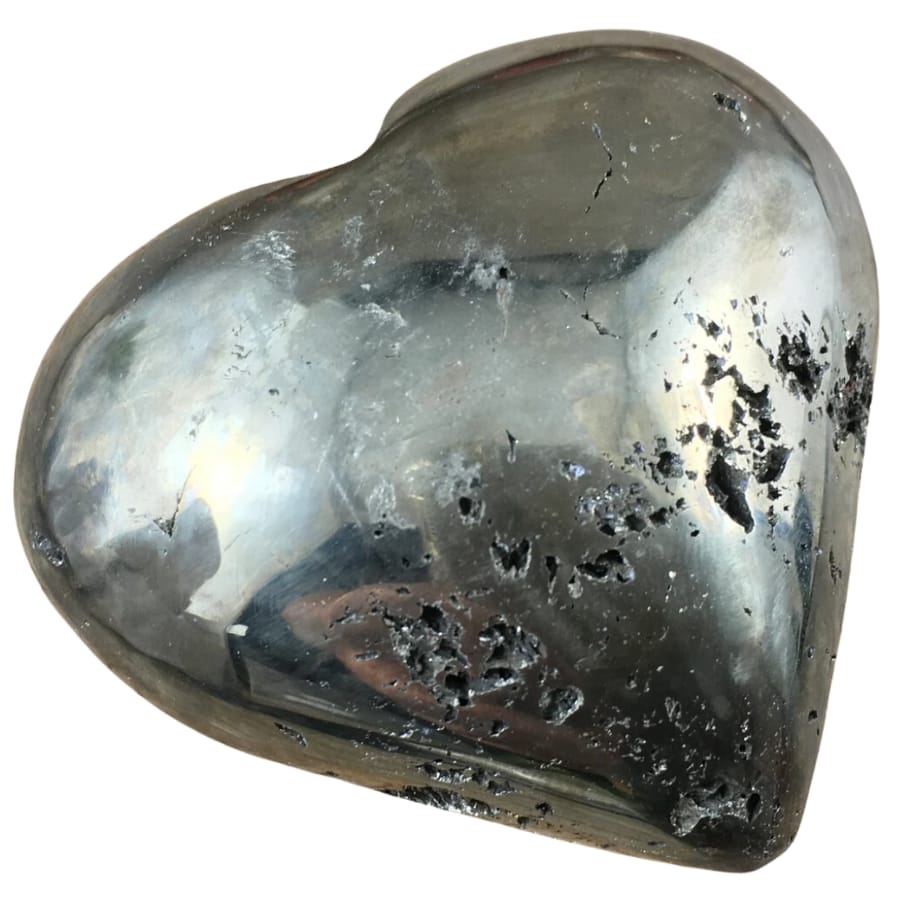
Checking the uniformity of color is a good way to identify fake pyrite, especially when it’s cut and polished. Real pyrite has a natural, brass-yellow color, but it’s not always exactly the same all over.
There can be slight variations in shade or even small imperfections. This is because real pyrite forms in nature, and natural things often have little differences and flaws.
Now, if the pyrite you’re looking at has a color that looks too perfect, like it’s the exact same shade of gold everywhere with no variations, it might be fake.
Fakes, especially those made in a factory, can have a really uniform, almost too-perfect color. They don’t have those natural variations that real pyrite does.
So, if your pyrite piece looks too perfect in color, without any of those little natural changes, it could be a sign that it’s not real. Remember, nature isn’t perfect, and that’s often the beauty of it!
How To Identify Fake Pyrite When It’s Raw
Identifying fake pyrite, particularly when it’s in its raw form, involves a keen eye and knowledge of certain key characteristics.
Observing aspects like color uniformity, natural crystal structure, and the physical properties of the specimen can provide valuable insights.
We will explore these critical features, helping you distinguish genuine raw pyrite from its counterfeit counterparts.
Color difference
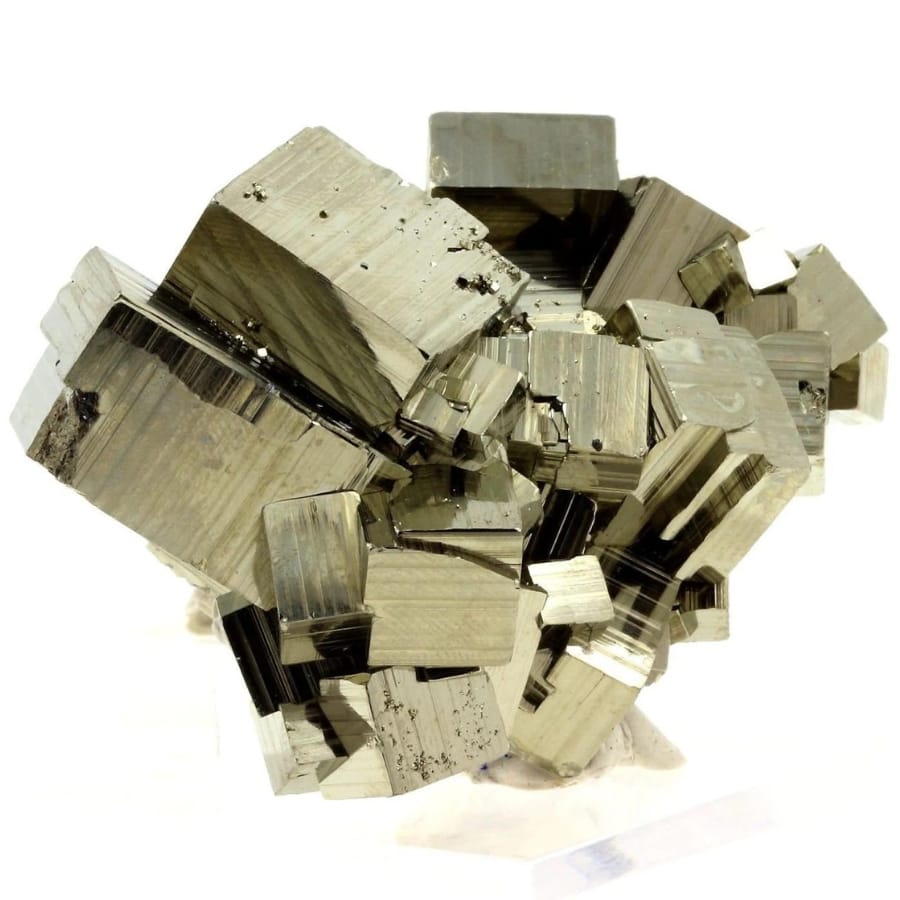
The color can tell you a lot about whether or not something is fake pyrite, especially if it’s raw. The color of real pyrite is very clear. And it shines like metal. It’s a brassy yellow color that looks a bit like dull gold.
When you look at real pyrite, this color stays the same, but it’s not very bright. It’s also important to see how the light bounces off of it. When light hits real pyrite, it shines like metal.
If you look at a piece and the color doesn’t seem right—like it’s too bright or shiny, like fool’s gold—it might not be real. To make you think it’s more expensive, some fake pyrites are made to look shiny.
There may be small changes in shade or marks on real pyrite. It’s likely that the color is fake pyrite if it looks too good or too bad, like it was put on or is too shiny.
Remember that real pyrite is a metallic brass-yellow color, not a very bright gold color, and it should have some natural differences in its color.
Lack of metallic luster
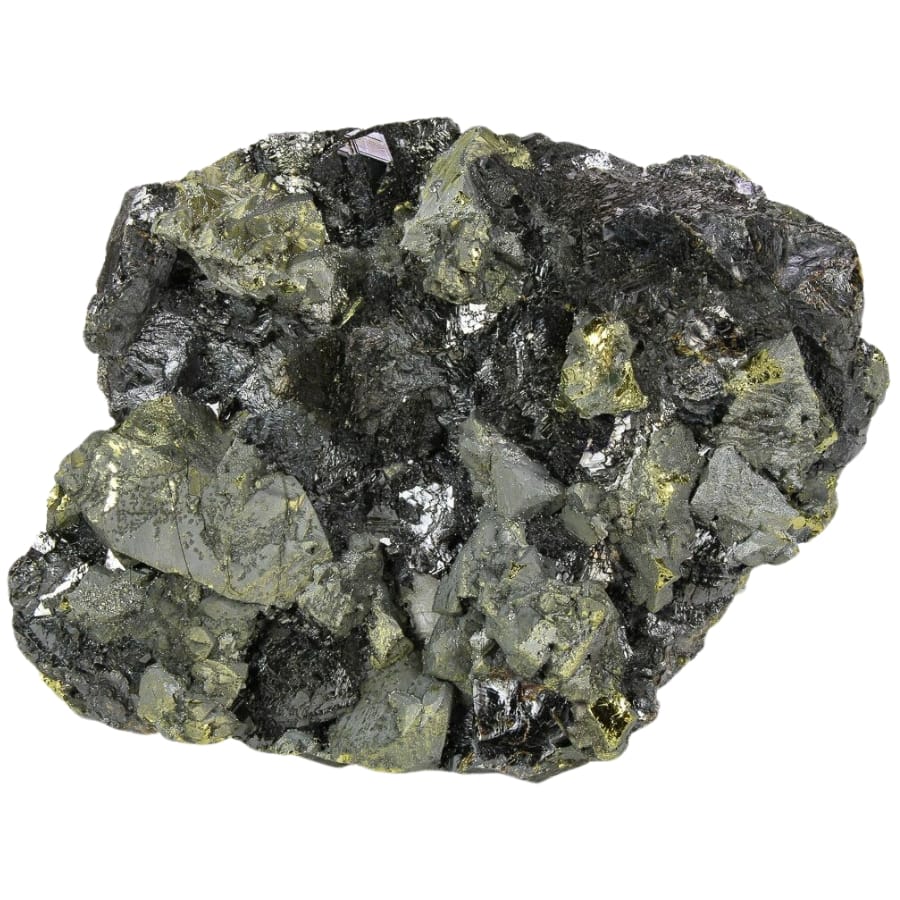
Looking at the metallic luster, or shine, of a mineral is a great way to figure out if raw pyrite is fake. Real pyrite has a very specific kind of shine that’s like metal.
This means when light hits it, pyrite should sparkle brightly, almost like how polished metal reflects light. It’s a key feature of pyrite, and it’s why people often call it “fool’s gold.”
Now, if you have a piece of raw pyrite and it doesn’t have that bright, metallic luster, it might be a fake. Sometimes, fake pyrite can look dull or not shine much at all.
It might just look glossy, but not in a metallic way. This is a big clue. Real pyrite should look really shiny, especially under good lighting.
Measure the weight
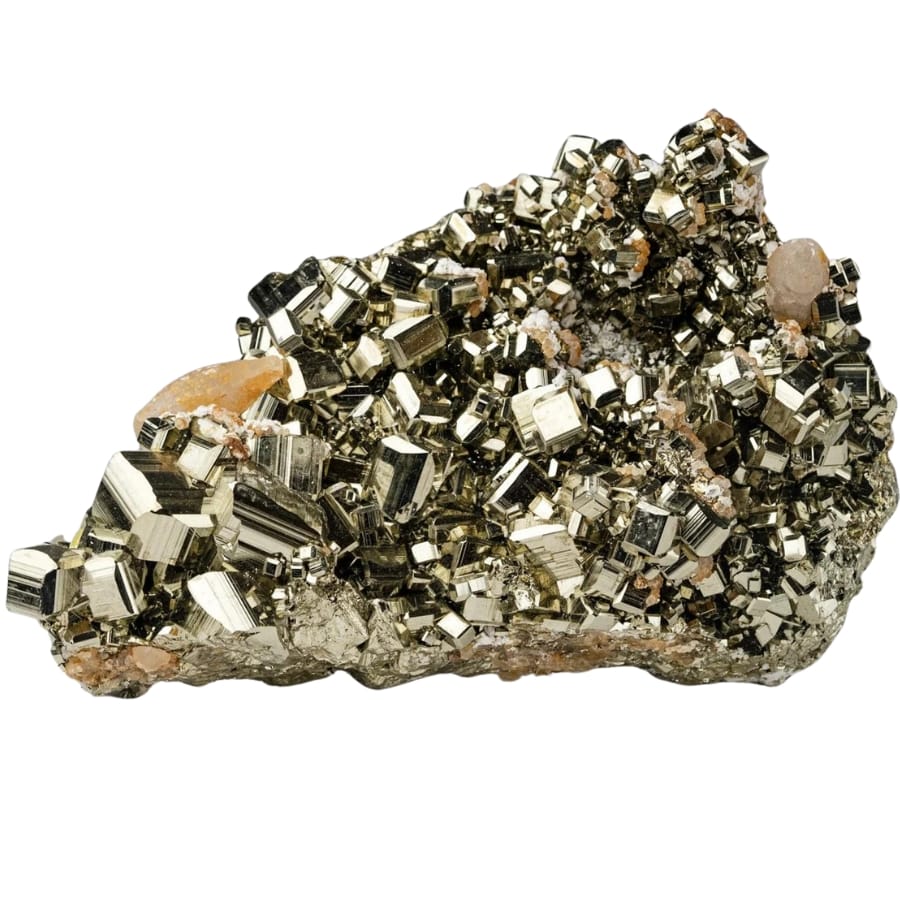
Measuring the weight is a really helpful way to figure out if raw pyrite is fake. Pyrite, which is also known as “fool’s gold,” is a pretty heavy mineral for its size.
That’s because it’s made of iron and sulfur, which are both heavy elements. So, when you pick up a piece of real pyrite, it should feel heavy.
If you have a piece of what you think is pyrite, try holding it in your hand. Does it feel heavy for its size, or does it feel surprisingly light? If it’s lighter than you expect, it might be fake.
Some fake pyrite is made with lighter materials, like plastic or resin, and these materials don’t weigh as much as real pyrite.


